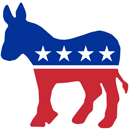Lowers corporate taxes by 10 percentage points (from 35 percent to 25 percent) and calls for lifting
moratoriums on energy exploration in the U.S. and building the Keystone XL pipeline.
Calls for $50 B to be spent on surface transportation priorities and $10 B for the establishment of a
national infrastructure bank. Also provides additional funding for education and public safety jobs and jobs for veterans. Provides funding for re-employment testing and training as part of the "Make It in America" agenda.
Encourages the prioritization of job creation as the most important budget item - in areas such as public safety, green jobs, childcare, mass transit and education - focusing on communities with the worst unemployment levels.
Promotes increased investment in the green economy, such as developing "green energy centers of excellence" at Historically Black College and Universities (HBCUs), and increases spending above the president's budget in education, research, natural resources and energy. Supports the establishment of a
national infrastructure bank.
Enacts
Title II of the Jobs Through Growth Act (H.R. 3400) which includes a timeout on all new regulations that create significant costs for job creators until unemployment falls to 7.7% or less, among others.
Fully funds the SNAP program, as a mandated program. Reduces
direct subsidies to agriculture.
Provides continuing assistance for unemployed workers and their families, including extended unemployment benefits for the long-term unemployed, COBRA subsidies, food stamps (SNAP) and other safety net programs.
Provides increased assistance for unemployed workers and their families, including extended unemployment benefits for the long-term unemployed, food stamps (SNAP) and food and nutrition servie (WIC). Ends subsidies for junk and fast food advertising to children and reduces direct subsidies to agriculture.
Disallows the cuts to SNAP, WIC and other programs found in the Republican budgets.
Reduces agriculture spending by $54 B over 10 years.
Privatizes Fannie Mae and Freddie Mac, ending taxpayer subsidies. Adds federal time limits and work requirements for housing assistance.
Not addressed by the budget.
Privatizes Fannie Mae and Freddie Mac and ends taxpayer subsidies.
Repeals the Affordable Care Act.
Maintains the Affordable Care Act.
Maintains the Affordable Care Act and calls for the restoration of $5 B to the
Prevention and Public Health Fund to transform our "sick" care system to one that promotes wellness and preventive care.
Maintains the Affordable Care Act and creates a public health insurance option. Also adopts the generic prescription drug development and release proposals from the president’s budget.
Maintains the Affordable Care Act and creates a public health insurance option in the state exchanges and increases spending by $10 B.
Repeals the Affordable Care Act.
Maintains status quo and keeps the cuts included in the Affordable Care Act. Switches to a voucher program that subsidizes the cost of a private plan, raises the age of eligibility from 65 to 67 and reopens the "
donut hole" starting in 2023.
Lauds the cost containment provisions included in the Affordable Care Act, prevents reopening of the "donut hole" and sets a deficit-neutral reserve fund for Medicare improvement. Also, rejects voucher or premium support approaches.
Supports negotiation for cheaper drug prices in
Part D. Rejects reopening of the "
donut hole," raising the age of eligibility and cuts in Medicare physician payments (so-called "
doc fix") for a decade.
Supports negotiation for cheaper drug prices in Part D and prevents cuts in Medicare physician payments (so-called "
doc fix") for a decade.
Maintains status quo.
Maintains status quo. Switches to a voucher program that subsidizes the cost of a private plan starting in 2023.
Makes Medicaid a
block grant program, giving states control. Also cuts funding by $810 billion — or 22 percent — over the next 10 years (doesn’t include Medicaid expansion in ACA).
Maintains Medicaid for low-income families.
Maintains Medicaid for low-income families and rejects block grants.
Creates a public option drug plan as in Medicare.
Maintains Medicaid for low-income families.
Makes Medicaid and the
Children’s Health Insurance Program (CHIP) block-grant programs, giving states control. Also cuts funding by $1.1 trillion - or 30 percent - over the next ten years (doesn’t include Medicaid expansion in ACA).
Makes the Bush tax cuts and preferential rates on capital gains and dividends permanent. Consolidates the income tax rate into two brackets – 10 percent and 25 percent. Cuts corporate tax rate from 35 to 25 percent. Eliminates
Estate Tax,
Alternative Minimum Tax (AMT) and a number of unspecified exemptions.
Extends the middle class tax cuts, ends $1 trillion in tax cuts for millionaires, establishes a "
Buffett Rule," opposes tax breaks that incentivize sending jobs overseas.
Calls for shared responsibility and a simpler tax code that closes certain loopholes for corporations and individuals.
Extends middle class tax cuts, eliminates Bush tax cuts, taxes capital gains and dividends as ordinary income, enacts a high-net-worth surcharge and new surcharges and tax brackets for millionaires and billionaires (adding 45-49 percent top rates), enacts financial speculation tax, and closes certain loopholes for those in the 28 percent bracket and above.
Extends middle class tax cuts; eliminates Bush tax cuts; taxes capital gains and dividends as ordinary income; enacts a high-net-worth surcharge on top earners; enacts a financial speculation tax; closes certain loopholes and denies mortgage interest deduction on vacation homes and yachts.
Prevents any tax increases. Maintains the preferential rates on investment income and consolidates the income tax rate structure into two brackets – 15 percent and 25 percent – and closes most loopholes. Cuts corporate tax rate from 35 to 25 percent. Eliminates the estate tax, AMT and the investment tax on inflation. Reduces taxes by up to $234 B in 2013.




